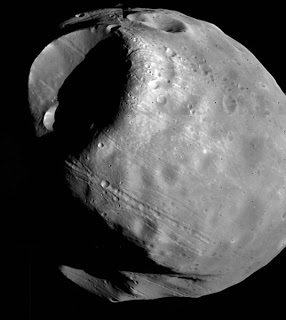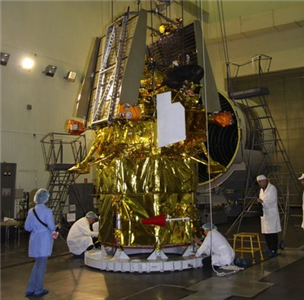OKLAHOMA CITY – We have been watching the drama involving the ailing Russian Phobos-Grunt (a.k.a Fobos-Grunt or “Phobos-soil”) spacecraft with great interest, as the probe appears to be stranded in Earth orbit, likely to re-enter the Earth’s atmosphere and burn up, perhaps as soon as next month.
In fact, latest reports on the $170 million Phobos-Grunt craft suggest that Russian scientists “have given up on any hope of regaining even minimal control” over the probe and that it is likely breaking apart, if reports from the U.S. Army Strategic Command, as reported today in The Moscow Times, are accurate.
Launched on Nov. 9 (11/9/11) from the Baikonur Cosmodrome in Kazakhstan, Phobos-Grunt was designed to take a trip to the potato-shaped Martian moon of Phobos where it would take samples of its soil and return to Earth in 2014. It would have been the first spacecraft On board was China’s first Mars probe, Yinghuo-1. It was rocketed into low-Earth orbit and two thrusters that would have sent it on its way to Phobos failed to operate.
And now that it is expected to crash back to Earth, there is concern about the highly toxic hydrazine and nitrogen tetroxide onboard. But it is simply expected to burn up before hitting Earth.
So what caused the Phobos-Grunt to fail? It’s not really clear. Speculation, conspiracy theories and more have been offered up. After all, it is Phobos that had former NASA astronaut and Moon landing hero Buzz Aldrin publicly talking about the mysteries of Phobos, one of Mars’s two moons, the other being Deimos.
Said Aldrin on C-SPAN in July 2009: “…(V)isit the moon of Mars. There’s a monolith there – a very unusual structure on this little potato-shaped object (Phobos) that goes around Mars once every seven hours.When people find out about that they are going to say, ‘Who put that there? Who put that there?’ Well, uh, the universe put it there, or if you choose, God put it there.”
And photos do seem to show an unusual structure on the surface of the curious little moonlet.
Meanwhile, the Russians are extremely upset about this latest failure and are looking for someone to blame. Russian President Dmitry Medvedev, according to the British news site The Week, “has threatened severe punishment for anyone found responsible for the failure of the … Phobos-Grunt.”
Medvedev was quoted in a Nov. 26, 2011 Reuters report that the Phobos-Grunt failure and another recent disaster involving a cargo ship, taking food and fuel to the International Space Station, are embarrassing to Russia’s space program, Roscosmos, and that if it was sabotaged somehow or simply put together in a sloppy or careless way, they will pay for what they have done.
Medvedev said: “I am not suggesting putting them up against the wall like under Josef Vissarionovich (Stalin), but seriously punish either financially or, if the fault is obvious, it could be a disciplinary or even criminal punishment.”
Russian news network, RT, offered a report titled “Did U.S. ‘climate weapon’ knock-out Russian probe?”
 |
|
| Many Astrophysicists claim Phobos is artificial |
An interesting idea. It quotes General-Lieutenant Nikolay Rodionov who suggests that the HAARP station in Alaska – officially reported to “study … the ionosphere and its use for communication” – gave off “powerful electromagnetic radiation” and may have “affected the control system of the interplanetary probe.”
Of course Rodionov may be suggesting this to distract from the real causes, which may have been in its design. But its still an interesting idea. Another site. Joe Bowman’s Science Blog, asks if there is a “Mars curse,” considering the high number of failed probes that have tried making it to Mars.
You may remember that in the late 1980s, right before the Soviet Union fell, the Phobos 1 and 2 probes were launched for similar reasons. Phobos 1, launched July 7,1988, failed to reach its destination while Phobos 2, launched a week later, eventually did get to Mars in early 1989 and did take photos of the Martian moon, including the controversial “last photo” which included an alleged UFO of enormous size accompanying Phobos. Communication with Phobos was soon lost after this March 1989 photo was taken, leading the Phobos 2 team to say publicly that it was lost either due to a computer malfunction or an “impact event” by an unknown object. Other photos released to the scientific community by the Soviets may further explain their current interest in returning to Phobos 23 years later.
At the time, Dr. Marina Popovich, a former Soviet test pilot known as Russia’s “female Chuck Yeager,” smuggled out the photo — allegedly given to her by famed Soviet Cosmonaut Alexey Leonov and that both Soviet leader Mikhail Gorbachev and then-President George H.W. Bush discussed the photo at a European conference. Popovich, it should be noted “has been outspoken about UFO reality.”
And then there is the “Phobos-Grunt Conspiracy” video which posits the idea that it could reenter Earth, falling to the ground like a “supersonic toxic bomb.”
The video also reminds us that also on the Russian probe are The Planetary Society’s “Life Experiment” organisms. This part of the probe’s mission were it to succeed, would test “the survivability of microorganisms in the conditions of deep space” and is designed to study the “panspermia hypothesis that microogranisms have “traveled between planets sheltered deep inside space rocks,” according to Planetary.org. The aforementioned video also notes that these organisms could become more virulent while in space, as noted in prior Space Shuttle missions involving microorganism experiments.
And, bringing to mind the Cold War-era, U.S.-Soviet “space race” years, while Russia watches Phobos-Grunt’s orbit decay, leading to its obliteration, NASA successfully launched its own, new Mars rover, Curiosity, which will, as the Springfield (Mass.) Republican newspaper excitedly reported this week, “try to determine if there might once have been life of some sort on the Red Planet.”
Adds the Republican editorial: “It has all the elements of a good, old-fashioned drama, and the best of science fiction, too. The outcome is unknown. The possibilities infinite, thrilling.”
Indeed. Perhaps we are entering a new time for space exploration, although NASA’s current status and administrative bungling does not inspire much hope that space exploration is a top priority, as we have reported before in our Red Dirt Report piece “Humanity’s destiny lies in “the final frontier.”
At this time experts on space travel are suggesting that humans will likely go to Mars in the 2030s and that the mysterious moon of Phobos, as reported at the Daily Galaxy, “is a vastly promising location for future exploration.” Continuing, the article notes that Phobos “has long been an anomaly; its orbital characteristics suggest it may be hollow. More aggressive speculation suggests that Phobos may in fact be a derelict spacecraft of the ‘generation ark’ variety described by science writers such as Isaac Asimov.”
But the Daily Galaxy doesn’t stop there. It states that “unexplained surface features such as the numerous converging grooves, together with the conspicuous monolith-like formations, plus the possibility that Phobos harbors uneroded structures deserving of close attention.”
And clearly NASA is interested in the “monolith” or boulder or whatever it is because by investigating the object it “could answer questions about the moon’s composition and history.” Remember, NASA representatives, whether in official or unofficial capacity (think Buzz Aldrin), don’t go out publicly talking about mysterious monoliths on equally mysterious moons unless they really think there’s something there worth checking out (think Arthur C. Clarke’s 2001: A Space Odyssey and its sequels). After all, if Phobos is hollow and Earth’s Moon is also hollow, what does that say about those celestial bodies and their placement in space near those two planets? At this point one gets the impression that someone – or something – doesn’t want us poking around Phobos.
But despite these setbacks, many scientists, particularly back here in the U.S. are hopeful and look forward to visiting Phobos.
Quoting NASA imaging specialist Lars Fleming, the aforementioned Daily Galaxy article concludes: “If we can get to that object (the monolith/boulder), we likely don’t need to go anywhere else.”
Andrew W. Griffin is the editor of the RedDirtReport.com. He can be reached a reddirtreporter@gmail.com.
var linkwithin_site_id = 557381;
linkwithin_text=’Related Articles:’



Be the first to comment on "Cosmic Sabotage? Phobos-Grunt probe mysteriously disabled"